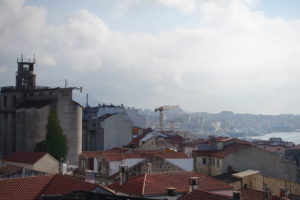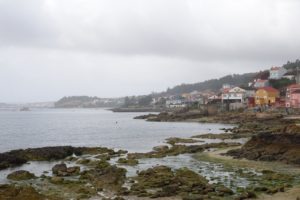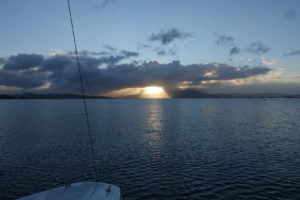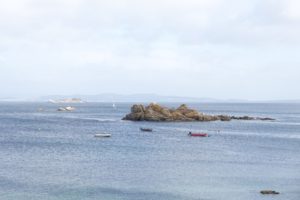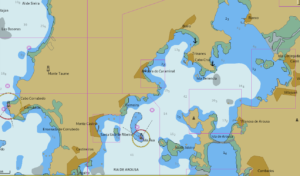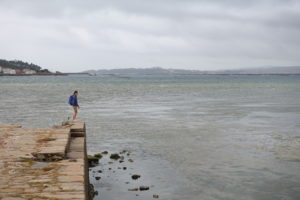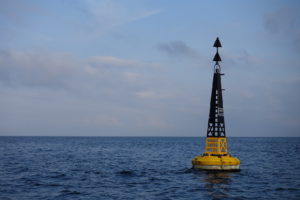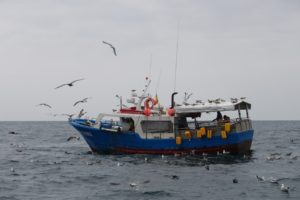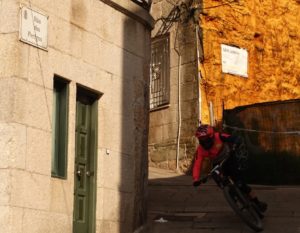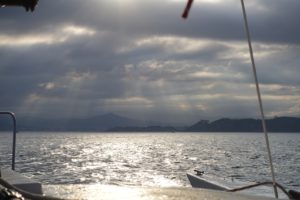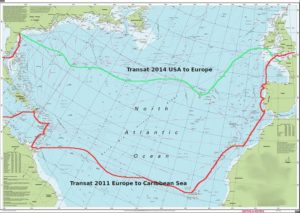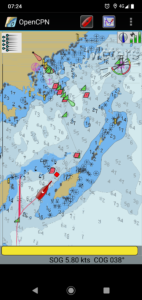It was four nights total we were in Galicia, and it’s been lovely! It is one of those places I really would like to return to and see more of. The weather is of course know for being windy and cold… like all the Celtic Nations regions I suppose. But there is such charm in the areas where the sea is so present in the land.
We were expecting a tourist heaven, and lots of people… but generally we saw only Galicians, and some Spanish tourists. No German, French or English. August is high season, so I’d say that when the coast of Brittany is going crazy with visitors, and Portugal also, during the months of June, July and August, then Galicia has to be one of the best places to hang out. I really think Galicia is one of the best areas to visit by boat on the Atlantic coast of Europe.
The first stop for two nights was Baiona, near Vigo. This is quite a big city, and we had a day to check it out. It’s an interesting mix of old and new, and there are traces of the different eras of the city everywhere. A cement factory is mixed in with what now is residential areas. It seems building new is more in line with the economy than tearing down the old and disused.
We had some luck with the events happening during our visit. They had a downhill mountain biking event in the city for example. Seems pretty dangerous to be going at those speeds surrounded by concrete and stone walls everywhere! Also, they had BMX championships and other associated events such as break dancing etc. Great performance by everyone, and it was a hot day too!
After the anchorage at Baiona we sailed the 25 miles to Ria de Arosa, the third Ria counting from the South. There we spent one day walking the entire length of the North coast of the Ria de Arosa, about 22 kilometres in total. The coastline is a mix of small river-mouths, towns and harbours, but mostly beaches and rocky outcroppings, very similar to those found in Brittany.
We have made friends, learnt about the local fishing and some of what they do for food grown locally. We talked about income, the problem of illegal shellfish fishing, and about the rainy weather they get a lot of the year!
However, going back to the topic of food; a lot of food is grown in the areas around the towns, or even in town if the garden space allows. Main crops are maize, brussels-sprouts, tomatoes and pumpkins. There are orange groves, and lemon trees, lots of wall-nut trees and chestnut, avocado, apricot and plums. Apple and pear are found everywhere too, and of course almond trees too. It seems to be a fantastic place to grow fruit and vegetables!
Then there is the ocean, right next door… with all the delicious food which can be found there, besides the trawling and long-lining tuna fishing, they do a lot of shellfish and octopus catching, and farming a particular type of shellfish is also done extensively.
Galicia is a peaceful place, and I think from our short stop I am already concluding that the people who live there are open and helpful, as well as friendly with visitors.
The region is suffering similar issues as other rural parts of Europe. An ageing population, a very high dependence on the car, and failing public transport. Work is not well paid, and housing costs are high, both renting and buying.
It’s quite extraordinary how many abandoned and for sale buildings there are when you start to look about. Whole villages have been emptied in the last 50 years or so. It’s a development which has taken place in most of Weastern Europe, but here it still seems to be a little more recent that people have left the countryside.
Another thing, eating out and going for drinks, a topic of utmost importance!It’s rare to find nowadays in Spain, but if you buy a pint of beer you get a tapas included, and the prices, well, it’s €2.50 for a pint. The Tapas we had were Mexillones, a shellfish; the one they farm. Most places a plate like would probably have cost more than €10.00 alone. Service is fantastic, and tips are not a foregone conclusion. I have to say that it is a real pleasure going out for the evening for food. I would imagine though, that in wintertime the places which are open for business would be many fewer.
So, for next time visiting Galicia the plan would have to include exploring inland between Ria de Arosa and Ria de Muros. Apparently that peninsula is historically very important, and was a major site for the Vikings. I guess the Vikings saw little challenge in crossing the Bay of Biscay! Indeed, there is a lot more to learn about the region.
I’d also like to go up the Rio Ulla, and see the beaches and salt-ponds around Isla de Arosa… but in all honesty – there is just so much to see around the region! Fantastic hiking (it’s the region for the Camino de Santiago de Compostella after all), and endless coves and anchorages and rivers to explore by boat.
